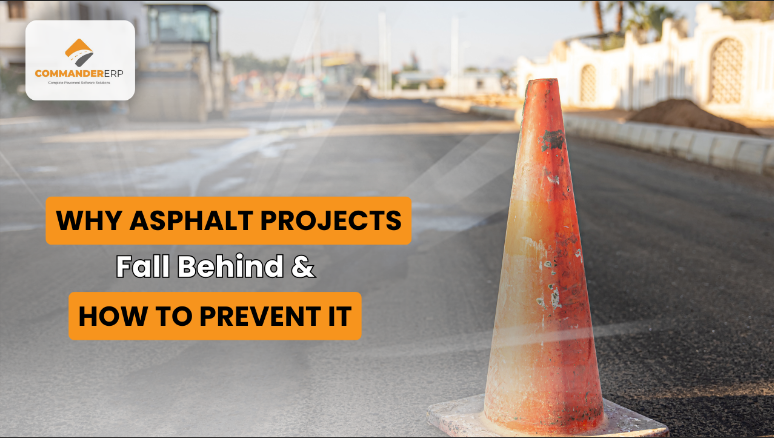
x
c
o
m
m
a
n
d
e
r
e
r
p
Blog
- Home
- Blog
- Commander ERP
- 2025-09-30
Why Do Traditional Road Maintenance Methods Struggle to Keep Up?
Despite decades of investment, the roads we drive on every day continue to deteriorate at an alarming pace. Governments and municipalities spend billions annually to repair cracks, patch potholes, and resurface highways, yet the same problems return time and again.
This raises an important question: why do these challenges persist? The issue is not just the volume of traffic or the impact of weather, but the outdated nature of traditional road maintenance practices themselves.
For too long, road infrastructure has been managed reactively rather than proactively. What is needed now is a smarter, technology-driven approach to pavement management one that focuses on efficiency, prevention, and sustainability.
Crumbling Roads in a Growing World: The Strain on Infrastructure
Roads are the lifelines of modern economies, connecting cities, powering logistics, and enabling trade. However, they are now under unprecedented strain. Rapid urbanization has resulted in more vehicles than ever before, with highways and city roads carrying traffic levels that far exceed their original design.
According to several infrastructure studies, vehicle usage has increased by over 50% in major cities within the last two decades, while maintenance budgets have barely grown in proportion.
On top of that, climate change adds another layer of complexity. Roads face extreme heat in the summer, freezing conditions in winter, and flash flooding in many regions, all of which accelerate deterioration. Traditional maintenance budgets cannot keep pace with these environmental stresses. As a result, agencies often find themselves in a constant race to patch problems instead of preventing them, creating an endless cycle of damage and repair.
Stuck in the Past: Why Traditional Road Maintenance Fails
Traditional road maintenance relies heavily on outdated methods that no longer meet today’s infrastructure demands. In most regions, the approach is reactive repairs happen only after visible damage occurs.
By the time a pothole appears on the surface, the underlying structure of the pavement is often already compromised, requiring far more expensive interventions.
Inspections are another area where traditional methods show their limitations. Many agencies still depend on manual site visits, with inspectors noting down issues on paper or spreadsheets.
This process is time-consuming, prone to human error, and often delays the flow of information between field workers and decision-makers. Without real-time insights, planning becomes guesswork.
Budget allocation under traditional systems also suffers. Funds are frequently directed toward emergency repairs instead of preventative maintenance, meaning money is wasted on recurring problems rather than long-term solutions. Over time, this approach shortens the lifespan of road networks and drains public resources.
The Hidden Costs of Outdated Practices on Public Safety
The consequences of outdated road maintenance practices extend beyond infrastructure budgets. Public safety is one of the most significant concerns. Poorly maintained roads increase the likelihood of accidents, damage vehicles, and put both drivers and pedestrians at risk. According to transportation research, thousands of accidents annually can be linked directly to poor road conditions. These are preventable incidents that continue to occur because infrastructure agencies remain stuck in reactive maintenance cycles.
The financial burden is equally troubling. Emergency repairs often cost two to three times more than preventative interventions, yet because of inefficiencies, agencies are forced to spend disproportionately on last-minute fixes.
Taxpayers ultimately bear the cost of these inefficiencies, leading to frustration and declining trust in public agencies. In addition, delays caused by construction and repair backlogs affect the broader economy, slowing down logistics, increasing fuel consumption, and reducing overall productivity.
Socially, poor road maintenance erodes confidence in government bodies and contractors responsible for keeping infrastructure reliable. Citizens expect safe, smooth, and efficient roads, and when this expectation is not met, dissatisfaction grows. Over time, this loss of trust becomes one of the greatest intangible costs of traditional road maintenance practices.
Smarter Pavement Management: A New Way Forward
For infrastructure to truly keep pace with modern challenges, road maintenance must move beyond patchwork solutions. A smarter approach to pavement management introduces centralization, efficiency, and foresight into the process.
Instead of relying on reactive repairs, modern systems allow agencies to anticipate when and where damage will occur, enabling proactive interventions that save both time and money.
Digital platforms can create centralized records of every road asset, offering decision-makers a complete view of the network. With this information, agencies can analyze deterioration patterns, schedule targeted interventions, and make data-driven decisions about which roads to prioritize. This shift ensures that limited budgets are no longer wasted on repeated fixes but rather invested strategically for maximum impact.
Smarter pavement management is not simply a technological upgrade; it is a cultural shift from short-term firefighting to long-term planning. By adopting proactive strategies, agencies can extend the life of their road networks, enhance safety, and deliver infrastructure that supports both present and future demands.
From Guesswork to Data: The Power of Modern Pavement Systems
One of the most significant changes in modern pavement management is the use of data. Traditional methods relied heavily on human observation and intuition, but today’s systems harness advanced analytics to deliver precise, actionable insights.
By collecting and analyzing data on road conditions, weather patterns, and usage levels, agencies can forecast deterioration before it becomes visible. This predictive capability allows for preventative maintenance, reducing the need for costly emergency repairs.
Automation further strengthens this process. Field inspections that once required manual paperwork can now be digitized, with mobile applications and connected devices transmitting information instantly to central databases.
Reports that previously took weeks can now be generated in real time, providing decision-makers with immediate visibility into road conditions. With this level of transparency, budgets can be optimized, repairs can be prioritized based on urgency, and overall efficiency is greatly improved.
This shift from guesswork to data is transformative. It empowers agencies to plan with confidence, justify funding requests with concrete evidence, and build public trust by delivering measurable improvements in infrastructure quality.
Roads of Tomorrow: Building Sustainable Infrastructure Today
Looking ahead, the future of road maintenance is firmly rooted in sustainability and resilience. Smarter pavement management systems enable agencies to act preventatively, ensuring that problems are addressed long before they escalate. This not only reduces costs but also minimizes disruptions for citizens and businesses.
In addition, the move toward sustainable practices means adopting construction materials and techniques that are environmentally friendly and longer lasting.
By integrating proactive planning with greener technologies, agencies can align their maintenance efforts with broader goals such as reducing carbon footprints and supporting smart city initiatives.
The benefits extend well beyond financial savings. Safer roads lead to fewer accidents, reduced fuel consumption, and improved traffic flow, all of which enhance the overall quality of life for citizens. Over time, smarter maintenance strategies ensure that road networks become assets that contribute to economic growth, rather than liabilities that drain public resources.
Conclusion: Moving Beyond Old Habits
The evidence is clear: traditional road maintenance methods are reactive, inefficient, and no longer sustainable in the modern world. They cannot keep up with growing traffic, unpredictable weather, and shrinking budgets. By contrast, smarter pavement management systems offer a proactive, data-driven approach that saves money, improves safety, and extends the lifespan of critical infrastructure.
It is time for governments, municipalities, and contractors to move beyond outdated practices and embrace innovation. By adopting modern systems like CommanderERP, agencies can ensure that our roads remain safe, efficient, and sustainable not just for today, but for generations to come.



